Where To Mount Camera When Backpacking
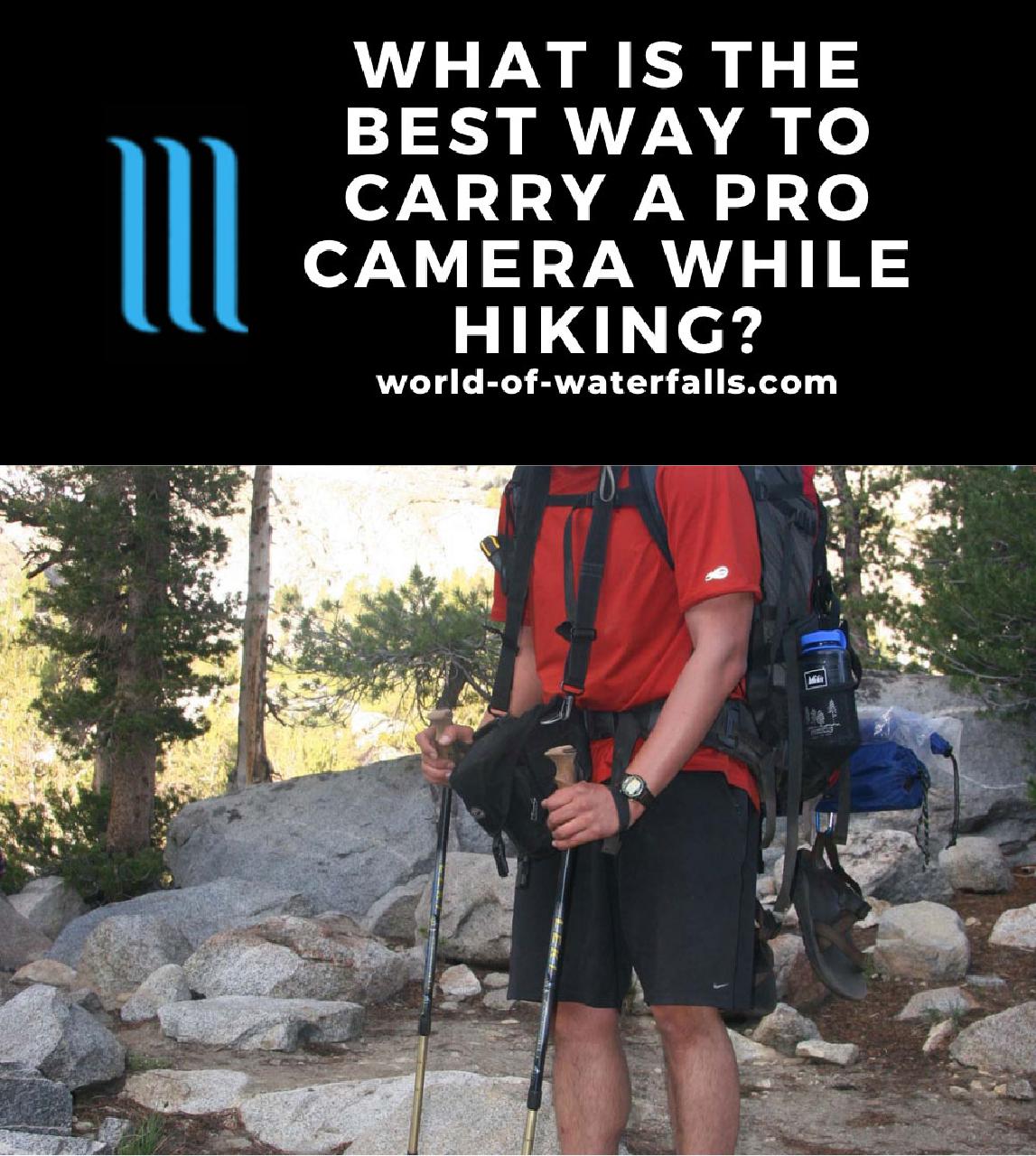
Trying to figure out what is the best manner to bear a pro photographic camera when hiking has been one of the most frustrating aspects most incorporating photography into my nature-based adventures. I've got the sore neck and shoulders, the rubbing marks, and even a chronically annoying tender shoulder bract issue to prove it. I've also got cracked lenses, zoom lenses that jam, and kits that have been exposed to water. And all these ailments can be traced back to how I've unsuccessfully carried my cameras on my by hikes and adventure travels.
Indeed, this has been one of my biggest pet peeves fifty-fifty going back since early on 2006 when I finally started to ditch the old signal-and-shoot cameras for the more professional person digital SLR ones.
I'll be the first to admit that even to this day, I nevertheless haven't found a photographic camera conveying system or solution that totally suits me while hiking and traveling abroad. After all, I primarily hike in varied conditions, especially in or effectually water since I chase waterfalls a lot.
That said, over these years, I have settled on a relatively cheap system that came from years of trial-and-error. Yet, I'm still on the lookout man for something that addresses all the major bug, which I'll discuss in-depth in this commodity.
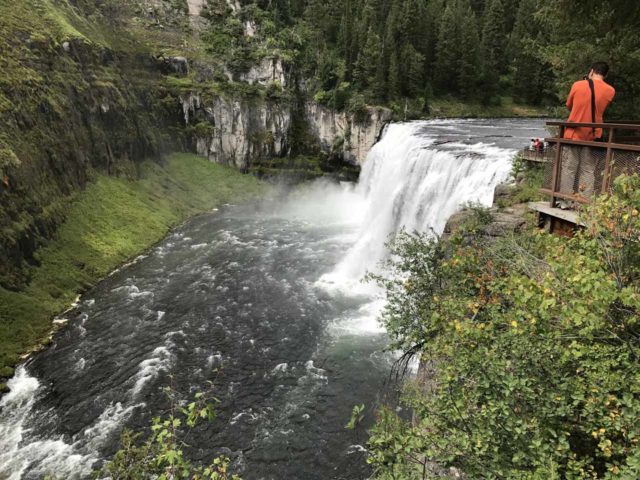
While I have a feeling that maybe my pain points are very particular, at the aforementioned fourth dimension, I too take a gut feeling that my grievances are not that uncommon either…
Why Practice I Care Virtually Photographic camera Carrying Systems Or Solutions?
I intendance nearly how I carry a professional or semi-pro camera when hiking because it is both heavy and fragile. While one can contend whether conveying such cameras is necessary, that'due south a totally different topic.
I'll but straight up say right now that iPhones still tin can't do the job that professional person cameras can. That said, the smart phones continue to close the gap while pro camera vendors seem to rest on their accolade.
Anyways, using professional and semi-professional cameras presents a serial of challenges and pain points that I'd take to overcome if I insist on the speed and prototype quality that I'd go from them.
Avoiding Chronic Discomfort and Ailments
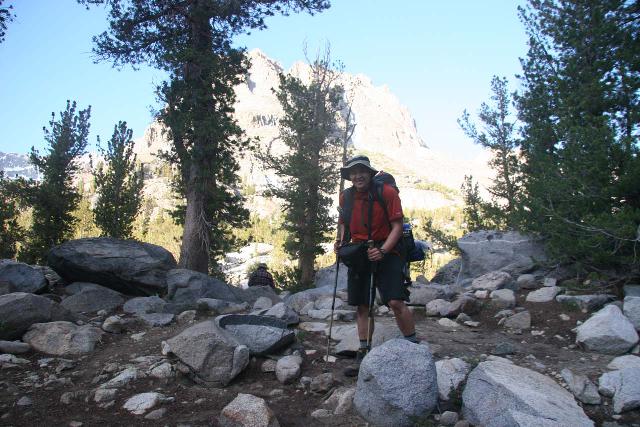
Even though mirrorless cameras may help with the bulk and weight of the camera'southward body, the lenses yet dictate epitome quality, speed, and zoom (among other things). In fact, more of than not, the lens comprises the majority of majority and weight of the entire camera.
In my experiences, my semi-pro cameras came in equally low-cal every bit the Sony Alpha7 3 Mirrorless Camera with 24-105mm F4 1000 OSS Lens at 3 lbs i.9 oz. On the other paw, my Catechism EOS 70D with EF 70-200mm i:4 L Lens weighed 3 lbs viii.6 oz.
So conveying around this much weight (not to mention how delicate they are) while hiking and carrying other things in a day pack (like water, rain gear, food, first-help, etc.) for several hours becomes cumbersome.
Over fourth dimension, this results in chronic discomfort and ailments, which ultimately impact my ability to hike and sightsee (i.e. the very activity I enjoy doing in the offset place)!
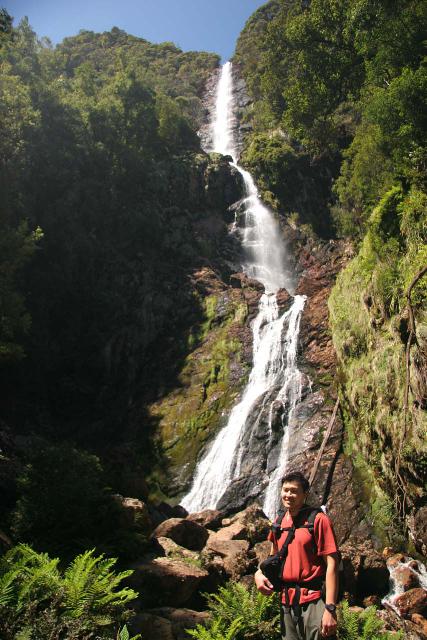
So the camera carrying system or solution would have to minimize the hurting of carrying effectually such cameras by redistributing its weight to a role of the body that'south better equipped to handle such loads.
Failure to recognize and remedy these issues leads to most of the chronic discomfort that make the experience less enjoyable, and even worse, it can be debilitating over time.
Avoiding Missing Precious Moments
I've learned that I typically don't get a 2d chance at fleeting moments that I want to capture on my camera.
Therefore, the speed at which I can both access the camera and be fix to shoot is a critical consideration in a camera carrying system.

If it takes too long to access the photographic camera, be in position to take that shot, and then finally click the shutter, well that moment may accept already passed by!
Therefore, I care about the best way to conduct my camera when hiking in order to access the photographic camera chop-chop and then I don't miss those rare moments.
Every fourth dimension I have to have a shot, I certainly don't want to fumble through a purse, pick out a lense, detach the current lens, put on the new lens, and put the old lens dorsum into the bag.
And practice all this before taking that shot! That takes way also much time.
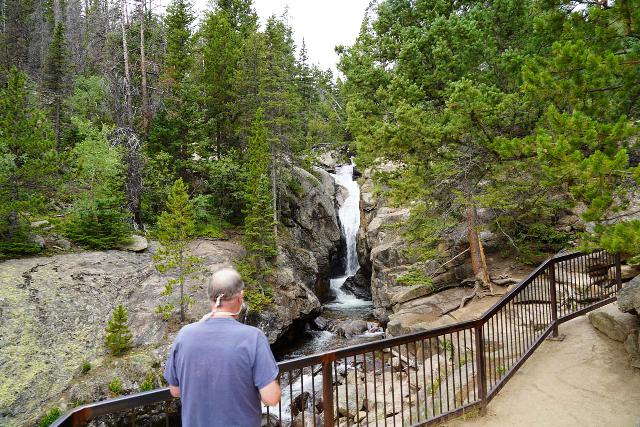
When I've been hiking for several hours, having to go through that tedious routine makes me not want to bother taking pictures, which would farther crusade me to miss those precious moments that I can't go back!
Fugitive Equipment Damage or Loss
Another primal attribute that I look for in a photographic camera carrying solution is its ability to protect the expensive camera and lenses.
No carrying organisation tin 100% foreclose damage, but we're talking about the carrying organisation'southward ability to reduce that likelihood of damage.
Therefore, the carrying arrangement must provide some degree of padding so the camera has less of a chance of damage from blunt trauma, especially against rocks or other hard surfaces frequently encountered on hikes.
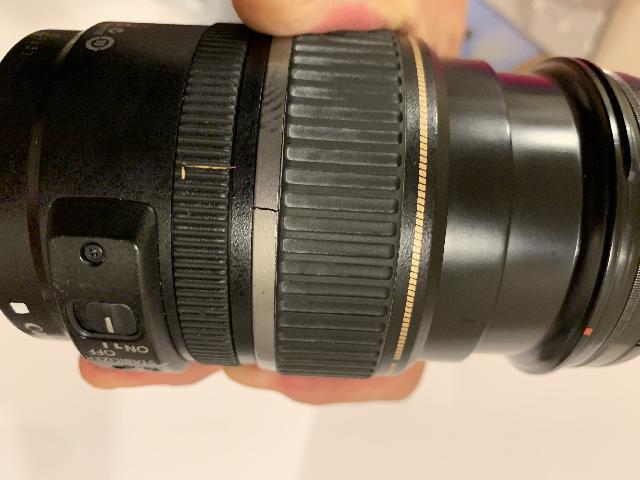
The carrying solution must also protect the camera and lens against h2o coming from rain, mist, or even unforeseen things similar wet vegetation and splash (from a pool or stream crossing).
After all, the photographic camera is pretty much disabled once water gets into its intricate system of electronics. Even weatherproofing seals can only exercise so much to prevent that situation.
The conveying system must likewise be sturdy enough to forbid it from bouncing every bit I walk, scramble, or even run.
Other things I wait for in a carrying system involve tethers or straps that help ensure that the camera won't be gone for expert (like at a cliff) if it happens to slip from my easily.
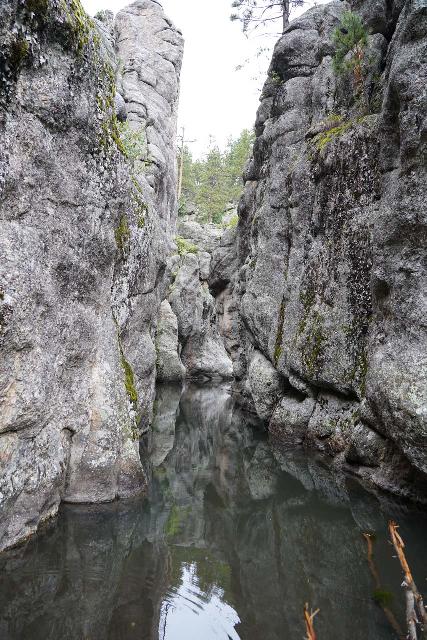
Given the professional camera'southward inability to handle water inundation, I am frequently faced with unexpected water obstacles where I either have to turn back or consider risking irreparable damage to proceed.
If the camera carrying bag happens to be waterproof, that would enable me to get past these obstacles and thus open up the possibilities of capturing more moments that otherwise wouldn't be possible or as well risky.
What Are The Commercially Viable Solutions So Far That I Have Considered?
Over the years, I've employed a variety of schemes to address carrying the camera.
Below are some of the ways that I've either bought and tried or at least considered, and the pros and cons of each of these camera carrying solutions.
Default Neck Strap
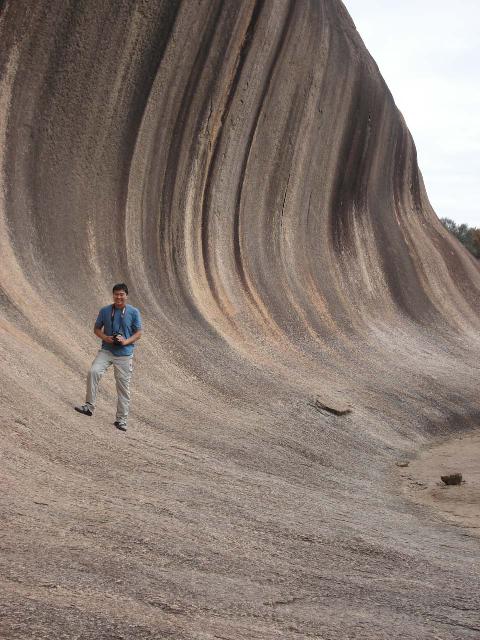
This is the most common solution mostly considering just about every mirrorless or DSLR camera purchased comes with this neck strap.
Pros:
- Hands Free
- No extra cost
Cons:
- Chaffs
- Leaves camera unprotected
- Gets in the way
- Twists and Tangles
Until recently, I've put upwards with leaving this strap attached to the photographic camera body merely in example I needed to accept it draped around my neck then I can handle some other photographic camera. This is quite a mutual occurrence, peculiarly since people often ask to accept their picture taken.
I also continue it draped around my neck or wrapped around my wrist if I'm about a dropoff and need that extra balls that I won't lose information technology forever.
Tamrac Farthermost Series Padded Waist Bag
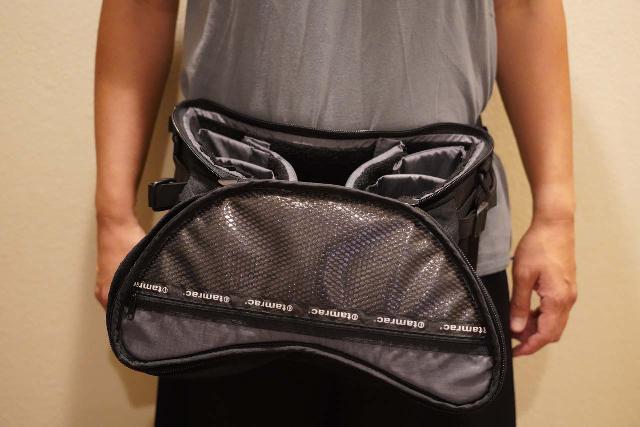
We possess the Tamrac Extreme Serial Padded Waist Purse considering Julie insisted that we buy and use it. Nosotros fifty-fifty had a fight about this as I was skeptical about using it back when we started looking for solutions to our camera carrying problem in 2006.
Pros:
- Accommodates Multiple Lenses
- Lots of configurable pockets and compartments
- Weight on the hip and legs
- Padded
Cons:
- Tiresome to be ready to shoot
- Beefy
- More than suited for studio/wedding ceremony photography than hiking
Sure enough, nosotros paid money at Samy's Camera (I forget how much, but it wasn't cheap) for this waist bag.
Withal, I've still never used information technology since its purchase and we've never returned information technology.
While this blazon of bag seems to take gravitated towards a more than backpack-hip-pack-dual-purpose design, it's just non suitable to the quick-access and agility that I need when hiking and traveling.
Tamrac 5627 Holster Bag
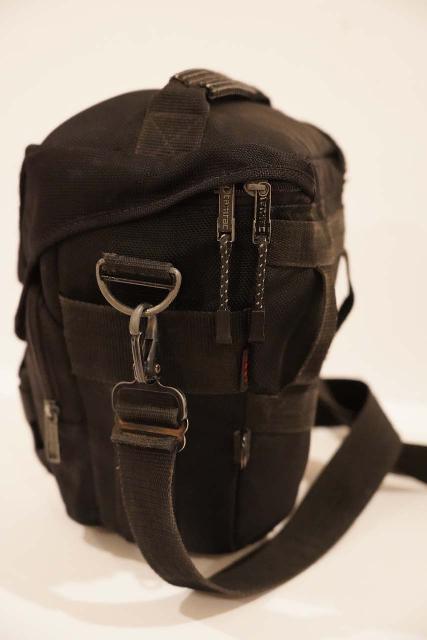
The Tamrac 5627 Holster Pocketbook is the pocketbook that I all the same apply to this twenty-four hour period because it's quite perchance the closest matter to the perfect holster camera bag that I've ever used.
Pros:
- Flip-top buckle fastener for quick access
- Loop for hip belt zipper (proficient weight distribution)
- Pockets for memory/cleaners/spare batteries, etc.
- Fits pro camera torso with zoom lens and lens hood attached (quick access)
- Padded
Cons:
- Discontinued (merely definitely NOT obsolete)
- Metallic clips not that durable
- Neither waterproof nor that water resistant
- Fraying materials and stitching (maybe nit due to old age)
- Tin can collect and put dust on camera lens
I find it a real shame that this bag has been discontinued because Tamrac's newer models take taken steps backwards from what this bag did correct.
Then I pass up to spend money on junior products and am often on the lookout to try to buy time until they or some competitor bring back all the things that made the Tamrac 5627 holster pocketbook so great.
Cotton wool CCS G3 Strapshot Holster Zipper
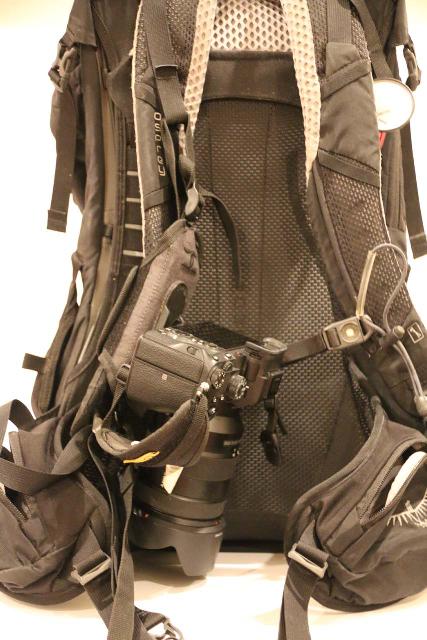
Julie bought me the Cotton fiber Carrier CCS G3 Strapshot Holster Attachment thinking that it might be useful because how my Tamrac 5627 holster purse carrying scheme is existence forced into obsolescence.
Then this was the offset solution we've tried to apply assuming the quick photographic camera access feature from the Tamrac 5627 bag would no longer be feasible.
Pros:
- Attaches to existing day pack or backpack
- Allows for hands-free carrying of photographic camera
- Tether for drop protection
- Comes with Hand/Wrist Strap
- Sturdy (won't permit photographic camera bounce while in motion)
Cons:
- Uneven weight distribution (on one strap over shoulder)
- Awkward to detach and/or remove camera
- Expensive for what you get
- Photographic camera unprotected when mounted
- Demand to pay for attachment to work with quick release tripod plate
- Velcro attachment will age/wear over fourth dimension
I've ultimately settled on committing to use this organization, but I'1000 finding that the holster attachment is not as useful equally the nearly $80 price would justify.
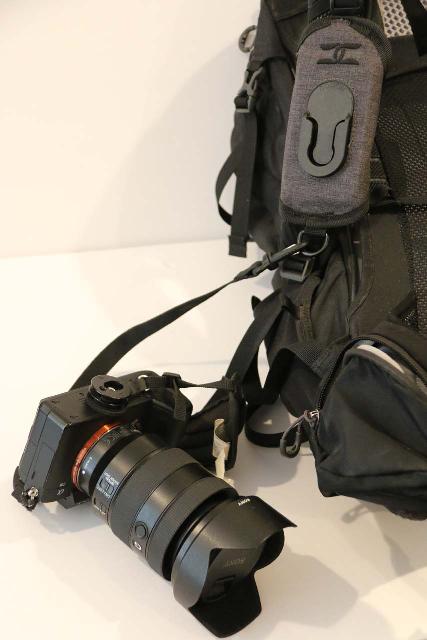
Yet, I did find the wrist strap to be a handy throw-in to this product.
I besides found the drop-proof tether to be useful.
That said, the tether is non long enough to permit me to extend my arms to shoot through the LCD. Shooting in this way is necessary, especially when a crowd of people stand in front of me while I yet need to have a shot.
Shoulder Harness
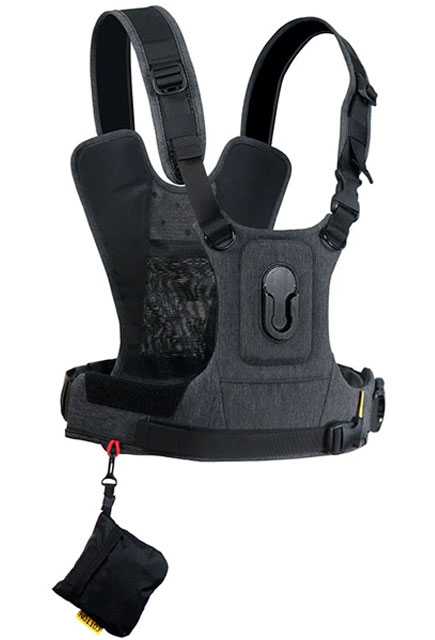
As I continued my search for a possible replacement for the discontinued Tamrac 5627 holster bag solution, I have looked heavily into the Cotton Carrier Harness too as the Call up Tank Photograph Digital Holster Harness.
The Cotton Carrier Harness is a military-style vest that allows the photographic camera to exist mounted directly on a chest plate on the harness itself. Thus, it won't work with attempting to protect the photographic camera with a camera bag while mounted.
Meanwhile, the Think Tank Photograph Digital Holster Harness allows for their camera holster bags to be attached such that it sits square in the lower chest or upper abdomen. Nonetheless, it may not piece of work with other holster bags.
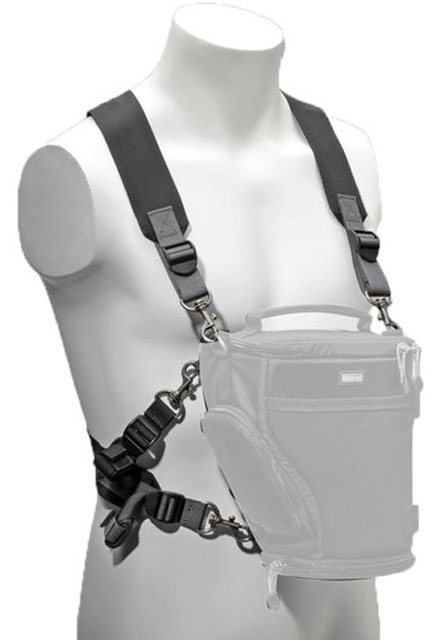
In my mind, both solutions have the following things I liked and didn't similar in common.
Pros:
- Centers weight distribution to mid-chest
- Quick admission
Cons:
- Weight still over shoulders and not on hips and legs (i.eastward. the strongest parts of the body)
- May not play well with twenty-four hour period pack and/or haversack (due to wearing multiple straps simultaneously)
- Pricey (notation that cheaper harnesses will allow camera to swing and bounce)
- May not exist necessary (if system of camera or bag straps/clips can already mate with existing day packs or backpacks such that camera is securely centered at lower breast or upper belly)
For these reasons, I still haven't committed to any of these harnesses.
How Take I Managed To Solve My Photographic camera Carrying Issues Right Now?
I have ultimately settled on a solution with the Tamrac 5627 holster bag attached to the hip chugalug of my twenty-four hours pack or internal frame haversack with its sling strap across my torso and over ane shoulder.
The over-the-shoulder strap stays on to ensure the bag (and camera) remain on me if I always have to unbuckle my hip belt (eastward.k. to heed nature's call) as well as to keep the strap from dangling or getting in the way.
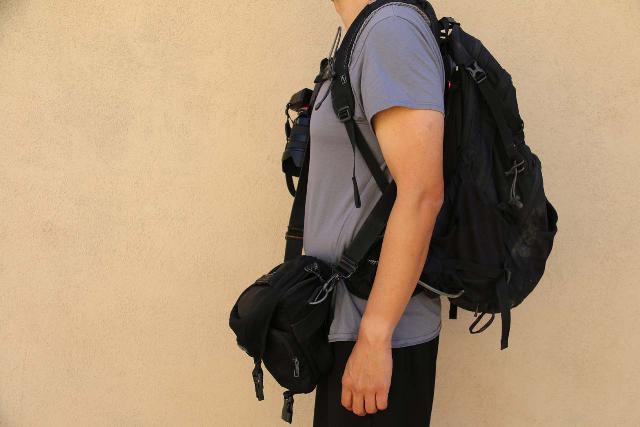
Meanwhile, the hip chugalug zipper ensures that the weight of the camera and lens sit on my hips and legs thereby relieving my shoulders and neck from this burden.
Moreover, the flip top buckle allows me to admission the camera with attached lens very quickly. As a hack, I more often than not get out the bag unzipped to further speed upward camera admission.
Even so, that hack also introduces the pocket-size likelihood that the camera and attached lens might clasp through the openings during apply (it hasn't happened to me notwithstanding, only I did have a couple of close calls).
Nevertheless, this flip peak buckle is something that I've noticed bag makers are removing in their designs, and yet it'south the very thing I expect for in society to become that quick access that zipper-only solutions can't match (not to mention zippers breaking and snagging).
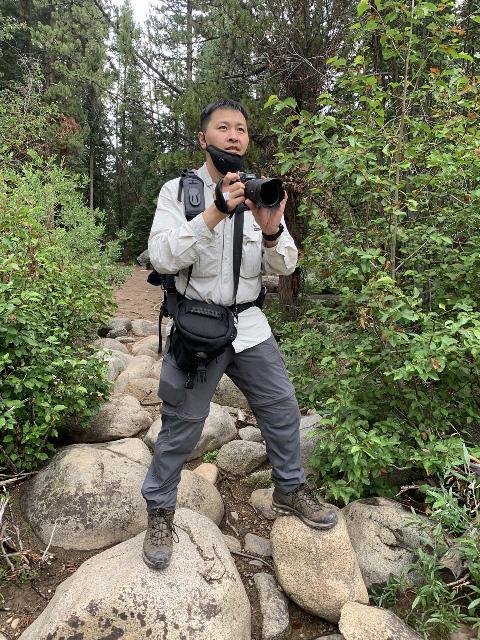
By itself, this solution has served me well for at least over xiv years, merely it does have its shortcomings.
For example, I have oftentimes held the camera in hand (and out of the handbag) for prolonged periods of time just so that I'thousand ready to take a photo at any moment.
However, my right hand would go sore if I unconsciously did this for several hours.
In gild to mitigate this issue, I have also attached the Cotton wool CCS G3 Strapshot Holster to the right strap of my twenty-four hour period pack or frame backpack.
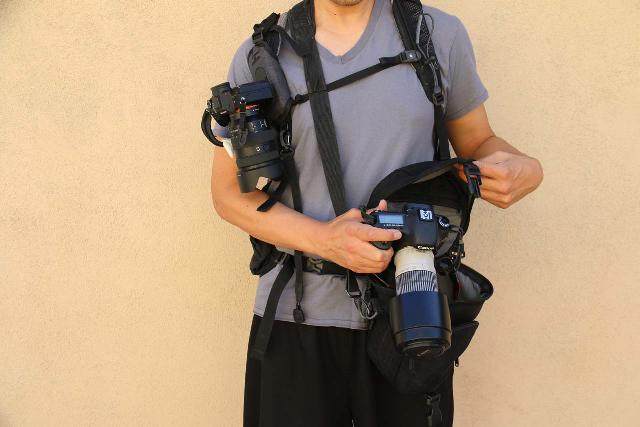
This allows me to free upwardly my hand or even carry two cameras (one fastened to the Cotton while some other is in the holster handbag).
I can debate that I probably don't really need the Cotton solution, but at least its detachable tether does give me the added slice of mind in the event that I do happen to drop the camera.
However, that included tether likewise limits how much I can extend my arms to take a shot by looking at the LCD instead of the eyepiece or viewfinder.
Luckily, while cleaning out the garage one solar day, we happened to stumble across a longer, sturdier, unused tether. Honestly, I know not from where that tether came from, but I'll take whatever little victory I can get given how all the costs on camera gear easily add together upwards! It looks simple enough to notice information technology sold on Amazon or eBay, or even as an included strap in some camera kits.
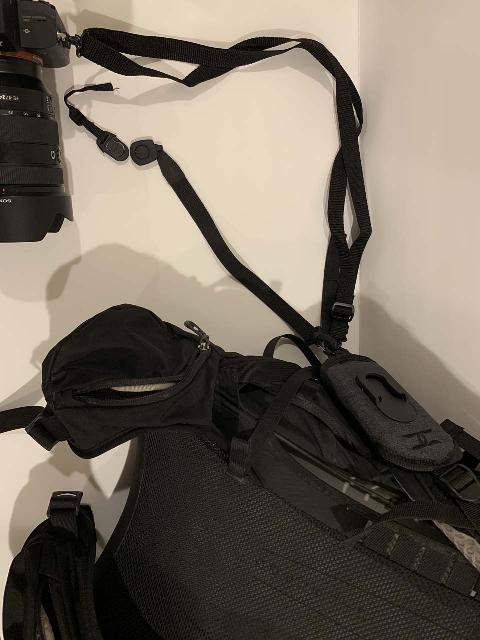
Indeed, this "re-discovered" tether is long enough to let me stretch out my arms completely to take a shot through the Sony Mirrorless' LCD. At the aforementioned time, the tether is still short plenty to prevent the photographic camera from hitting the ground if I drop it while standing up.
That said, this tether'due south clips still may not mate with some photographic camera bodies similar my Canon EOS 70D, which has a thinner ring that this clip won't loop through (though information technology would take to mate a less sturdier strap loop).
And so this tweaked rig has go the permanent tether that I now employ to mate with the Cotton wool Carrier G3 Strapshot attachment as well as my precious Sony Alpha7 iii Mirrorless camera body (thus the Cotton Carrier did serve to provide this extra bit of security).
Who Is My Photographic camera Carrying Solution (Or Search For It) For?
My way of carrying a pro camera when hiking is pretty much for day hikers or overnight backpackers needing to spend more fourth dimension in the outdoors and sometimes away from the established trails.
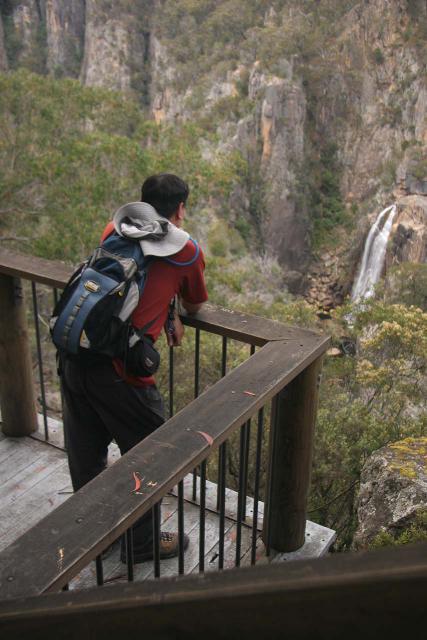
I also call up my scheme has served me well in my international travels in both crowded urban environments (where my holster bag becomes an over-the-shoulder bag) also as international hikes.
It'southward also compact plenty to fit into my solar day pack if bear-on restrictions call for say merely having my day pack (with camera in holster purse) and a laptop bag.
Both of these things I definitely wouldn't want to be checking in given the risk of theft likewise as damage from rough handling by baggage handlers.
In any case, fifty-fifty my camera carrying system has shortcomings like it's non waterproof and information technology'south too non future proof.
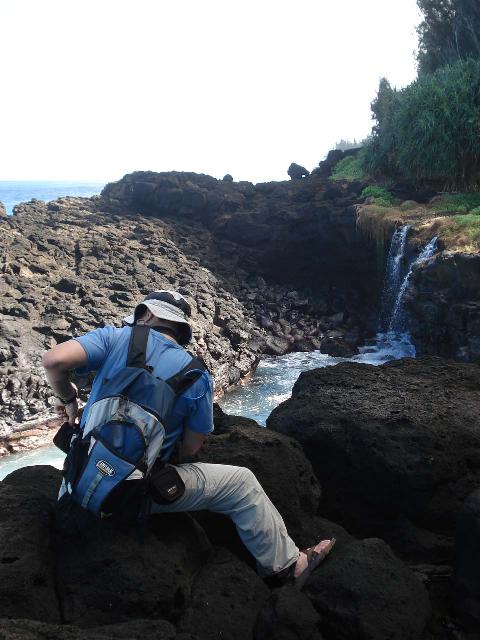
While the former tin be solved with a dry handbag (which would finally let me to get past water obstacles where I'd have no choice simply to get wet to keep), the latter is a big sore spot for me.
Afterward all, the Tamrac 5627 existence discontinued by Tamrac shouldn't be an issue, but its newer versions of the product took steps backwards from what Tamrac did right.
Even competing holster camera bags have not done what the Tamrac 5627 did well. For case, I haven't seen a holster bag in 2020 that had all of the following features at the aforementioned time:
- the quick flip elevation buckle fastener for easy and fast camera access
- the loop attachment for hip chugalug attachment for weight distribution on hips and legs
- the size that fits a Catechism EOS DSLR with an xviii-200mm zoom lens fastened with lens hood so the photographic camera's ready to shoot
- the pockets for spare memory, batteries, and lens cloths or sponges
- the compact shape so it doesn't make it the way of hiking
Indeed, I well-nigh feel like every solution out there primarily caters to professional photographers who brand a living in weddings, studios, or in fine art landscape photography.
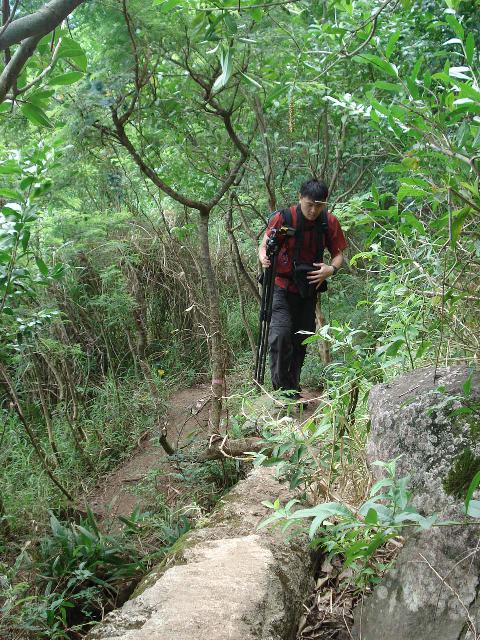
However, the outdoor charlatan, traveler, and/or hiker is similar a forgotten market place only incidentally catered to with ancillary features from the aforementioned markets (since they are likely to spend more on photographic camera gear).
And that's the biggest reason why I've been really frustrated and disappointed with the camera solutions on the market right now.
Final Thoughts / Conclusion?
Finding the best way to carry a pro camera when hiking has been both frustrating and elusive.
Granted, the needs of one photographer may be completely unlike from a different photographer.
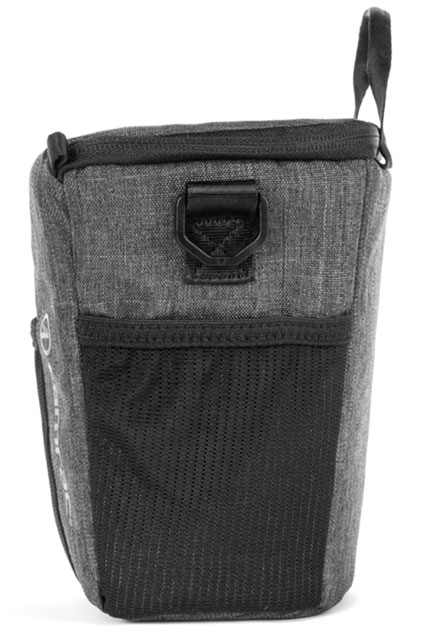
Thus, I've concluded that the perfect solution either doesn't exist, or the companies serving this market haven't met or no longer desires to encounter the demands that a hiker and adventurer like myself require.
I'm well aware that my solution that I've settled upon won't terminal for the long term given the way that camera carrying systems accept evolved and so far to proceed taking steps backwards away from what works in the field.
So information technology puts even more pressure level on people like myself to find a solution that suits such needs while dealing with the shortcomings that the commercial products seem to strength upon usa.
In theory, finding the best camera carrying solution shouldn't be this difficult and frustrating, and it's making me reconsider whether I should still commit to shooting with these heavy and beefy professional person cameras anymore.
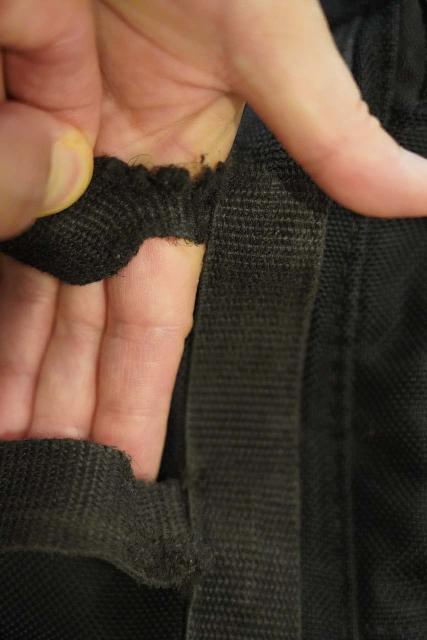
Even so I'm yet torn at the benefits that these cameras buy me over settling for iPhones which are improving, simply all the same don't practise the job in my mind when information technology comes to nature photography (especially regarding what I encounter in my adventures).
As a result, my endless search for the best manner to deport the camera while hiking continues…
Source: https://www.world-of-waterfalls.com/what-is-the-best-way-to-carry-a-pro-camera-when-hiking/
Posted by: cruzagivery1969.blogspot.com

0 Response to "Where To Mount Camera When Backpacking"
Post a Comment